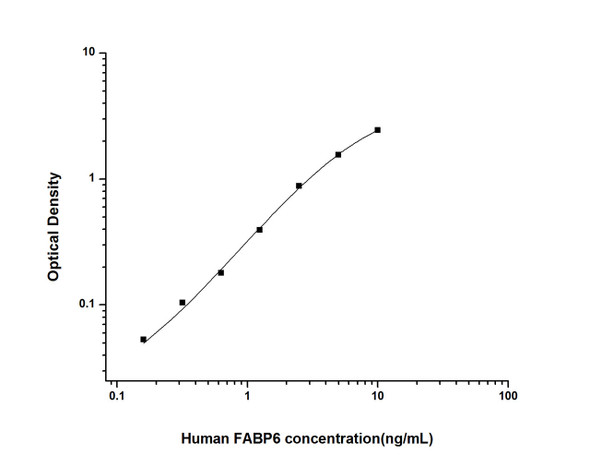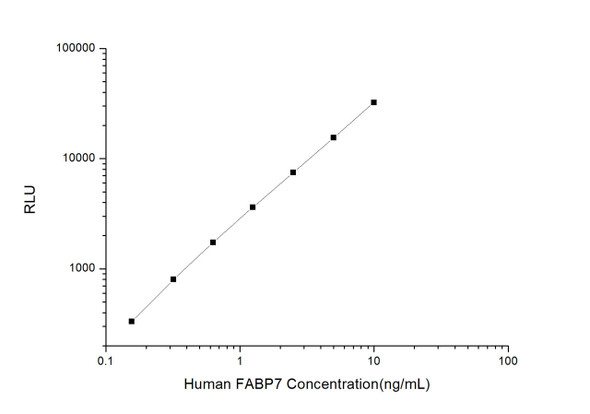Human Cell Biology ELISA Kits 4
Human FABP6 (Fatty Acid Binding Protein 6, Ileal) CLIA Kit (HUES00806)
- SKU:
- HUES00806
- Product Type:
- ELISA Kit
- ELISA Type:
- CLIA Kit
- Size:
- 96 Assays
- Sensitivity:
- 18.75pg/mL
- Range:
- 31.25-2000pg/mL
- ELISA Type:
- Sandwich
- Synonyms:
- I-15P, I-BABP, I-BALB, I-BAP, ILBP, ILBP3, ILLBP
- Reactivity:
- Human
- Sample Type:
- Serum, plasma and other biological fluids
- Research Area:
- Cell Biology
Description
| Assay type: | Sandwich |
| Format: | 96T |
| Assay time: | 4.5h |
| Reactivity: | Human |
| Detection method: | Chemiluminescence |
| Detection range: | 31.25-2000 pg/mL |
| Sensitivity: | 18.75 pg/mL |
| Sample volume: | 100µL |
| Sample type: | Serum, plasma and other biological fluids |
| Repeatability: | CV < 15% |
| Specificity: | This kit recognizes Human FABP6 in samples. No significant cross-reactivity or interference between Human FABP6 and analogues was observed. |
This kit uses Sandwich-CLIA as the method. The micro CLIA plate provided in this kit has been pre-coated with an antibody specific to Human FABP6. Standards or samples are added to the appropriate micro CLIA plate wells and combined with the specific antibody. Then a biotinylated detection antibody specific for Human FABP6 and Avidin-Horseradish Peroxidase (HRP) conjugate are added to each micro plate well successively and incubated. Free components are washed away. The substrate solution is added to each well. Only those wells that contain Human FABP6, biotinylated detection antibody and Avidin-HRP conjugate will appear fluorescence. The Relative light unit (RLU) value is measured spectrophotometrically by the Chemiluminescence immunoassay analyzer. The RLU value is positively associated with the concentration of Human FABP6. The concentration of Human FABP6 in the samples can be calculated by comparing the RLU of the samples to the standard curve.
| UniProt Protein Function: | FABP6: Ileal protein which stimulates gastric acid and pepsinogen secretion. Seems to be able to bind to bile salts and bilirubins. Isoform 2 is essential for the survival of colon cancer cells to bile acid-induced apoptosis. Belongs to the calycin superfamily. Fatty-acid binding protein (FABP) family. 2 isoforms of the human protein are produced by alternative promoter. |
| UniProt Protein Details: | Protein type:Lipid-binding Chromosomal Location of Human Ortholog: 5q33. 3-q34 Cellular Component: cytoplasm; cytosol Molecular Function:transporter activity; lipid binding Biological Process: bile acid and bile salt transport; negative regulation of cell proliferation; bile acid metabolic process; lipid metabolic process; transmembrane transport |
| NCBI Summary: | This gene encodes the ileal fatty acid binding protein. Fatty acid binding proteins are a family of small, highly conserved, cytoplasmic proteins that bind long-chain fatty acids and other hydrophobic ligands. FABP6 and FABP1 (the liver fatty acid binding protein) are also able to bind bile acids. It is thought that FABPs roles include fatty acid uptake, transport, and metabolism. Transcript variants generated by alternate transcription promoters and/or alternate splicing have been found for this gene. [provided by RefSeq, Jul 2008] |
| UniProt Code: | P51161 |
| NCBI GenInfo Identifier: | 1708457 |
| NCBI Gene ID: | 2172 |
| NCBI Accession: | P51161. 2 |
| UniProt Secondary Accession: | P51161,Q07DR7, Q8TBI3, Q9UGI7, |
| UniProt Related Accession: | P51161 |
| Molecular Weight: | 128 |
| NCBI Full Name: | Gastrotropin |
| NCBI Synonym Full Names: | fatty acid binding protein 6, ileal |
| NCBI Official Symbol: | FABP6 |
| NCBI Official Synonym Symbols: | ILBP; I-15P; I-BAP; ILBP3; ILLBP; I-BABP; I-BALB |
| NCBI Protein Information: | gastrotropin; GT; intestinal 15 kDa protein; ileal lipid-binding protein; illeal lipid-binding protein; ileal bile acid binding protein |
| UniProt Protein Name: | Gastrotropin |
| UniProt Synonym Protein Names: | Fatty acid-binding protein 6; Ileal lipid-binding protein; ILBP; Intestinal 15 kDa protein; I-15P; Intestinal bile acid-binding protein; I-BABP |
| Protein Family: | Gastrotropin |
| UniProt Gene Name: | FABP6 |
| UniProt Entry Name: | FABP6_HUMAN |
As the RLU values of the standard curve may vary according to the conditions of the actual assay performance (e. g. operator, pipetting technique, washing technique or temperature effects), the operator should establish a standard curve for each test. Typical standard curve and data is provided below for reference only.
| Concentration (pg/mL) | RLU | Average | Corrected |
| 2000 | 50505 60937 | 55721 | 55693 |
| 1000 | 22001 25947 | 23974 | 23946 |
| 500 | 11382 10682 | 11032 | 11004 |
| 250 | 4886 5702 | 5294 | 5266 |
| 125 | 2715 2501 | 2608 | 2580 |
| 62.5 | 1406 1216 | 1311 | 1283 |
| 31.25 | 670 678 | 674 | 646 |
| 0 | 28 28 | 28 | -- |
Precision
Intra-assay Precision (Precision within an assay): 3 samples with low, mid range and high level Human FABP6 were tested 20 times on one plate, respectively.
Inter-assay Precision (Precision between assays): 3 samples with low, mid range and high level Human FABP6 were tested on 3 different plates, 20 replicates in each plate.
| Intra-assay Precision | Inter-assay Precision | |||||
| Sample | 1 | 2 | 3 | 1 | 2 | 3 |
| n | 20 | 20 | 20 | 20 | 20 | 20 |
| Mean (pg/mL) | 96.45 | 225.80 | 693.13 | 101.19 | 234.01 | 705.45 |
| Standard deviation | 9.63 | 17.97 | 54.27 | 11.32 | 22.68 | 61.02 |
| C V (%) | 9.98 | 7.96 | 7.83 | 11.19 | 9.69 | 8.65 |
Recovery
The recovery of Human FABP6 spiked at three different levels in samples throughout the range of the assay was evaluated in various matrices.
| Sample Type | Range (%) | Average Recovery (%) |
| Serum (n=5) | 91-106 | 98 |
| EDTA plasma (n=5) | 95-108 | 101 |
| Cell culture media (n=5) | 89-99 | 94 |
Linearity
Samples were spiked with high concentrations of Human FABP6 and diluted with Reference Standard & Sample Diluent to produce samples with values within the range of the assay.
| Serum (n=5) | EDTA plasma (n=5) | Cell culture media (n=5) | ||
| 1:2 | Range (%) | 99-117 | 100-115 | 102-120 |
| Average (%) | 107 | 105 | 110 | |
| 1:4 | Range (%) | 93-110 | 94-108 | 93-109 |
| Average (%) | 100 | 99 | 100 | |
| 1:8 | Range (%) | 95-108 | 94-107 | 99-115 |
| Average (%) | 101 | 101 | 107 | |
| 1:16 | Range (%) | 87-99 | 95-111 | 98-116 |
| Average (%) | 94 | 102 | 106 |
An unopened kit can be stored at 4°C for 1 month. If the kit is not used within 1 month, store the items separately according to the following conditions once the kit is received.
| Item | Specifications | Storage |
| Micro CLIA Plate(Dismountable) | 8 wells ×12 strips | -20°C, 6 months |
| Reference Standard | 2 vials | |
| Concentrated Biotinylated Detection Ab (100×) | 1 vial, 120 µL | |
| Concentrated HRP Conjugate (100×) | 1 vial, 120 µL | -20°C(shading light), 6 months |
| Reference Standard & Sample Diluent | 1 vial, 20 mL | 4°C, 6 months |
| Biotinylated Detection Ab Diluent | 1 vial, 14 mL | |
| HRP Conjugate Diluent | 1 vial, 14 mL | |
| Concentrated Wash Buffer (25×) | 1 vial, 30 mL | |
| Substrate Reagent A | 1 vial, 5 mL | 4°C (shading light) |
| Substrate Reagent B | 1 vial, 5 mL | 4°C (shading light) |
| Plate Sealer | 5 pieces | |
| Product Description | 1 copy | |
| Certificate of Analysis | 1 copy |
- Set standard, test sample and control (zero) wells on the pre-coated plate and record theirpositions. It is recommended to measure each standard and sample in duplicate. Note: addall solutions to the bottom of the plate wells while avoiding contact with the well walls. Ensuresolutions do not foam when adding to the wells.
- Aliquot 100µl of standard solutions into the standard wells.
- Add 100µl of Sample / Standard dilution buffer into the control (zero) well.
- Add 100µl of properly diluted sample (serum, plasma, tissue homogenates and otherbiological fluids. ) into test sample wells.
- Cover the plate with the sealer provided in the kit and incubate for 90 min at 37°C.
- Aspirate the liquid from each well, do not wash. Immediately add 100µL of BiotinylatedDetection Ab working solution to each well. Cover the plate with a plate seal and gently mix. Incubate for 1 hour at 37°C.
- Aspirate or decant the solution from the plate and add 350µL of wash buffer to each welland incubate for 1-2 minutes at room temperature. Aspirate the solution from each well andclap the plate on absorbent filter paper to dry. Repeat this process 3 times. Note: a microplatewasher can be used in this step and other wash steps.
- Add 100µL of HRP Conjugate working solution to each well. Cover with a plate seal andincubate for 30 min at 37°C.
- Aspirate or decant the solution from each well. Repeat the wash process for five times asconducted in step 7.
- Add 100µL of Substrate mixture solution to each well. Cover with a new plate seal andincubate for no more than 5 min at 37°C. Protect the plate from light.
- Determine the RLU value of each well immediately.






